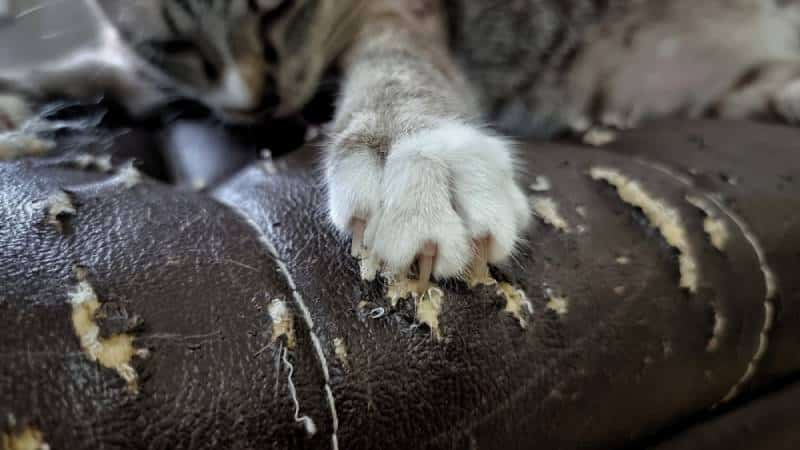Cats are delightful companions, but their scratching behaviour can be a real nuisance, especially if you have leather furniture. Understanding why cats scratch and implementing effective strategies can help preserve your furniture and keep your feline friend happy. This guide will provide you help with how to prevent cats from scratching leather furniture.
Understanding Why Cats Scratch
Cats scratch for several reasons: to mark their territory, stretch their muscles, and keep their claws sharp. Scratching is a natural behaviour, so it’s essential to provide alternatives and deter them from targeting your precious leather furniture.
Providing Alternatives
Cat Scratching Posts
Investing in sturdy scratching posts can save your furniture. Place these posts near the areas your cat likes to scratch. Sisal-covered posts are particularly attractive to cats.
Scratching Pads and Mats
Scratching pads and mats are also great alternatives. They come in various textures and can be placed on the floor or attached to walls. Rotate different types to keep your cat interested.
Cat Trees and Climbing Structures
Cat trees offer multiple benefits: they provide scratching surfaces, climbing opportunities, and cosy spots for napping. Place a cat tree near your leather furniture to divert your cat’s attention.
Using Deterrents
Double-Sided Tape
Cats dislike sticky surfaces. Applying double-sided tape to your leather furniture can deter them from scratching. Ensure the tape is safe for your furniture and doesn’t leave residue.
Citrus Sprays
Cats are generally repelled by citrus scents. Spraying a diluted citrus solution on your furniture can discourage scratching. Test on a small area first to ensure it doesn’t damage the leather.
Aluminium Foil
Covering furniture with aluminium foil can deter cats. The texture and sound of the foil are unpleasant to them. Use this as a temporary measure while training your cat.
Protecting Your Furniture
Furniture Covers
One easy way to keep your leather furniture protected is to use furniture covers. Select covers that are simple to take off and clean. They might also serve as a stopgap measure while you train your feline.
Slipcovers and Throws
Slipcovers and throws add an extra layer of protection. They can be stylish and functional, shielding your leather furniture from scratches and fur.
Leather Protection Products
Invest in leather protection products that help prevent scratches. These products form a protective barrier on the leather surface, reducing the risk of damage.
Training Your Cat
Positive Reinforcement
When your cat uses the approved scratching posts, reward them with goodies, compliments, or extra playtime. Encouraging them to repeat the desired behaviour is known as positive reinforcement.
Using Commands and Signals
Train your cat to respond to commands like “no” or “stop.” Use a firm but gentle tone and immediately redirect them to the appropriate scratching area.
Distracting with Toys
Distract your cat with toys when you notice them scratching the furniture. Interactive toys and laser pointers can keep them engaged and divert their attention.
Regular Nail Trimming
Importance of Trimming Cat’s Nails
Regular nail trimming reduces the damage caused by scratching. Trim your cat’s nails every few weeks to keep them short and blunt.
How to Safely Trim Nails
Use cat nail clippers and gently press on your cat’s paw to extend the claw. Trim the sharp tip, avoiding the quick (the pink part). If unsure, ask your vet for a demonstration.
Using Nail Caps
Nail caps are soft, vinyl caps that are glued over your cat’s claws. They prevent damage while allowing your cat to engage in natural scratching behaviour. Replace them every few weeks as needed.
Creating a Cat-Friendly Environment
Providing Entertainment and Enrichment
Ensure your cat has plenty of toys, climbing structures, and interactive playtime. A cat that is stimulated is less likely to become bored and start scratching things.
Establishing a Routine
Cats thrive on routine. Establish regular play and feeding times to keep your cat content and less likely to engage in destructive behaviours.
Reducing Stress and Anxiety
Stress and anxiety can lead to increased scratching. Create a calm environment with hiding spots and quiet areas for your cat to retreat to when needed.
Addressing Underlying Issues
Health Problems
Sometimes, excessive scratching can be a sign of health issues such as skin conditions or allergies. Consult your vet if you notice sudden or intense scratching.
Behavioural Issues
Behavioural issues like separation anxiety or boredom can lead to destructive scratching. Address these issues by providing more interaction and mental stimulation.
Consult a Vet or Behaviourist
If you’re struggling to manage your cat’s scratching, seek advice from a vet or animal behaviourist. They can provide tailored solutions based on your cat’s specific needs.
Using Pheromone Sprays
Benefits of Pheromone Sprays
Pheromone sprays mimic natural cat pheromones, creating a sense of calm and security. By spraying them on your furniture, you can lessen scratching caused by tension.
How to Use Them Effectively
Spray pheromones on areas where your cat tends to scratch. Follow the manufacturer’s instructions for best results and combine with other deterrents and training methods.
DIY Solutions
Homemade Scratching Posts
If you’re handy, consider making your own scratching posts using materials like sisal rope and wooden posts. Make them unique to your cat’s tastes.
DIY Deterrent Sprays
Create your own deterrent sprays using natural ingredients like vinegar and water or citrus peels. Spray these on your furniture to keep your cat away.
Conclusion
Preventing your cat from scratching leather furniture requires a combination of providing alternatives, using deterrents, and training. With patience and consistency, you can protect your furniture and keep your feline friend happy.
FAQs
Why do cats prefer scratching leather?
Cats enjoy scratching leather because it’s durable and provides a satisfying resistance. Leather also retains the scent marks from their paws, which is part of their territorial behaviour.
How often should I trim my cat’s nails?
Trim your cat’s nails every 2-3 weeks. Regular trimming helps prevent damage to furniture and reduces the risk of your cat’s nails getting caught or broken.
Are there specific materials that deter cats from scratching?
Cats generally dislike sticky, slippery, or crinkly surfaces. Using materials like double-sided tape, aluminium foil, or plastic covers can deter them from scratching certain areas.
Can I use essential oils as a deterrent?
Some essential oils, like citrus, can deter cats from scratching. However, be cautious as many essential oils are toxic to cats. Always use diluted solutions and ensure they are safe for pets.
What should I do if my cat still scratches the furniture despite all efforts?
If your cat continues to scratch despite trying various methods, consult a vet or animal behaviourist. They can provide additional strategies and identify any underlying issues contributing to the behaviour.



